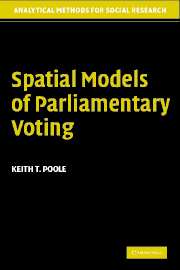Book contents
- Frontmatter
- Contents
- List of Tables and Figures
- Preface
- 1 Introduction
- 2 The Geometry of Parliamentary Roll Call Voting
- 3 The Optimal Classification Method
- 4 Probabilistic Spatial Models of Parliamentary Voting
- 5 Practical Issues in Computing Spatial Models of Parliamentary Voting
- 6 Conducting Natural Experiments with Roll Calls
- 7 Conclusion
- References
- Index
6 - Conducting Natural Experiments with Roll Calls
Published online by Cambridge University Press: 24 November 2009
- Frontmatter
- Contents
- List of Tables and Figures
- Preface
- 1 Introduction
- 2 The Geometry of Parliamentary Roll Call Voting
- 3 The Optimal Classification Method
- 4 Probabilistic Spatial Models of Parliamentary Voting
- 5 Practical Issues in Computing Spatial Models of Parliamentary Voting
- 6 Conducting Natural Experiments with Roll Calls
- 7 Conclusion
- References
- Index
Summary
Overview
A variety of natural experiments can be performed using roll call matrices. Some consist mainly of combining roll call matrices over time or introducing additional rows into the matrices to allow legislators to be treated as multiple individuals. Additional experiments are possible if the legislature is bicameral (that is, it has two chambers). For a bicameral legislature, the roll call matrices from the two chambers can be combined via the columns if enough roll calls with identical content were cast in the two chambers. Likewise, over time, if some legislators served in both chambers, then on the assumption that the legislator has the same ideal point in both chambers, we can combine the roll call matrices using these legislators.
Although I will concentrate my analysis below on bicameral legislatures, the same methods can be used for multiple legislatures provided that there are enough legislators who served in all combinations of the legislatures. An example would be a federal system where legislators serve at one time in a regional or state legislature and later in the national legislature. Provided there is enough overlap, the roll call matrices can be combined and analyzed.
We would use additional rows for a legislator who switches political parties. The question is: When a legislator switches from one political party to another, does her roll call voting behavior change? In order to test for the change, the simplest approach is to treat the legislator as two individuals – one before the switch and one after.
- Type
- Chapter
- Information
- Spatial Models of Parliamentary Voting , pp. 162 - 196Publisher: Cambridge University PressPrint publication year: 2005



